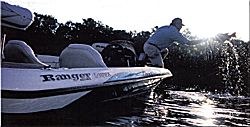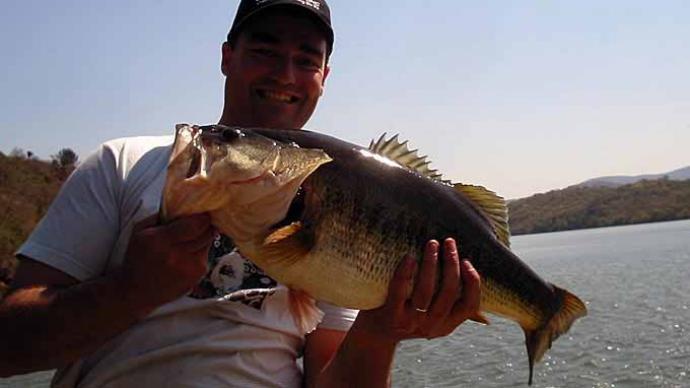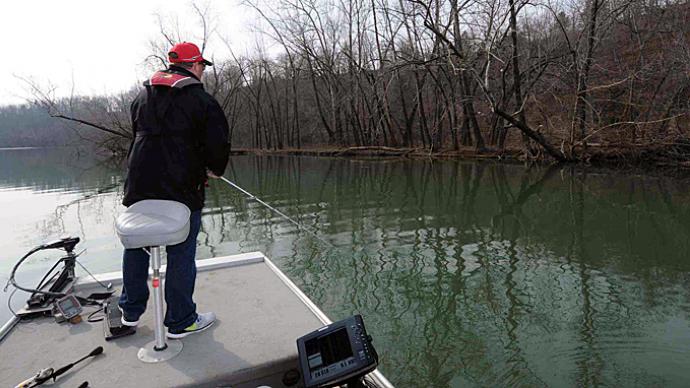
Bass are, by their nature, fish that relate to structure as a major governing factor in their daily existence. There are few more critical structures in an aquatic habitat than creek channels and drop-offs. Yet there are some rather important factors that fishermen need to realize about these potential holding places for bass. First, we'll look at some features and facts about channels.
I recently had a young fellow fishing in the back of my boat on a new impoundment with considerable standing timber left in the lake. Since he is an avid fisherman and hunter, I asked him to point out the channels' course without a depthfinder's help. Immediately, he gave me a look indicating he did not know. To begin with, I suggested he look at the trees on shore and tell me if he saw anything different about any of those on the bank as opposed to those in the lake. He began to note that those in the forest were straight, whereas some in the lake along the channels were leaning at sharp angles. After a little while, he was really into reading the channels and becoming more sensitized to picking out the bark patterns on willows, which told him that before there was a lake, there was a channel, slough, or pool in that area. The findings of pool dams by locating willow lines in lakes like Richland-Chambers were the key to locating prime bass fishing areas for years.
The other thing about a creek or river channel is that it often curves like a snake. The upper end of Lake Cooper was left as standing timber, with only the channel and crosscuts available for navigation. A local friend told me you could follow the Sulfur River channel from the first crosscut to the upper three cuts.
To begin with, it did not take me long to figure out there was a better way when I watched some locals follow the shoreline through a couple of cut fences along some tree lines, and you can get to the second cut in about a fifth of the time my channel cruising had taken. The channel is very narrow, and it appeared logical to proceed at a moderate speed since my insurance agent encouraged me to avoid fusing the lower unit into immovable wooden objects.
My buddy laughed when I explained that I had followed the river between the second and third cuts for about 30 minutes, only to realize I was back within 50 yards of where I had earlier been. His comment, "Didn't I tell you where to cut across through the timber?" was poorly received. The message is that any channel zigs and zags. I always enjoy seeing the maps with fish emblems on the bends of a channel. Sure, bends of a channel are potential holding spots, but there may be what seems like a zillion in a matter of a few hundred yards, particularly if it is a small and narrow creek.
The most crucial part of finding a productive area on a channel is to find out why fish should be there. A bend is a good place because a depth variation will always be adjacent to the shelf next to the channel. This will provide a natural spot for baitfish and other forage creatures to hold and thus attract bass. The other important thing about a channel bend is that if any current flows, the bend will result in current shifts, including whirlpools or eddies, which again encourages the accumulation of those creatures in the food chain.
Another critical aspect of an exemplary channel depends on whether there is cover like brush or vegetation, particularly on the shallower slope. The other question is whether areas of suitable habitat are outside the channel, such as shallower areas with vegetation or brush on flats. Of course, finding schools of baitfish on your depthfinder helps strongly suggest that you are in an area of the channel with a prime component for attracting bass.
Another factor that impacts the potential of a channel and a bend of the channel to hold bass is a change in the bottom of the channel itself. This is nowhere more evident than in older lakes, where once very productive places become dead zones. Nothing zaps a good holding area more than to have a deposit of silt and mud cover a previously sandy or gravel bottom. Bass often move away from these spots on a channel and, generally, do not return unless new growth in the form of vegetation occurs and reestablishes the stability of the bottom.
If you fish a channel, the other important factor in deciding which area should be the most productive is to ensure you are fishing on the lip or edge of the channel, which is in the more productive depth that fishermen have luck catching bass on that lake. A few minutes with the folks at the marina will often do wonders in helping you gauge the most likely depths on which you want to concentrate. A good map then should be used to see where the channels are located in various coves and regions of the lake.
A good rule of thumb in fishing channels is that you may want to go further up a creek or into shallower water in areas with more off-colored water than where you might start to fish in the creeks in the clearer parts of the take. One of the things that a creek channel or any drop-off offers is a barrier to sunlight. The bass will tend to always be on the shaded sides of the drop and will often shift as the angle of the sunlight changes during the day. These areas should be considered holding areas for bass rather than feeding areas. But from the fisherman's standpoint, it makes little difference in that you can often cause a bass to "feed" by placing bait in front of it.
There are several schools of thought on how to fish the edge of a creek channel or drop-off. One time you should fish in the deepest part is in the late fall, after a frontal passage. For the rest of the year, you can choose two basic approaches.
The first is to use the concept of one of the original (and legendary) Creme lure field staff, Tracy Woods. Tracy always said he wanted to fish from deeper to shallower on his retrieve of a bottom-bumping worm. His logic was that you should envision a depth change, including a creek edge or drop-off as a stair-step scenario. He felt that you could fish each step on the way in if you went against the depth change, whereas if you fished from shallower to deeper on the retrieve, you could skip several steps.
When a fisherman has a good idea of the location of the edge of a drop, then a pitching or flipping technique can be the choice for presenting the lure in the sheltered area where there is the most significant potential for a bass to be holding. If you are a crankbait guy like me, you may want to angle your casts so that they cut the edge of a channel and are at a certain depth (hopefully the one within the greatest potential for eliciting a strike) for the longest time. In the case of a straight channel, you might even want to parallel cast along an edge and try to work the bait along the lip.
When we say that we are going to fish a channel or drop, one has to be sure we recognize that a change in depth can be very subtle in some cases. A change of only a couple of feet in an area of grass or hydrilla will still act like a magnet for concentrating bass. In the same mode, some of my most productive areas on heavily fished takes are those secluded little feeder creeks that run into the main channel or from coves. Sure, some of these are very small and only hold a few bass, but usually, everyone overlooks them and goes to the more obvious places. When fishing such small areas, developing the ability to have a silent presentation is vital. The bait may be a lizard or other soft plastic or even a jig-and-pig, but your productivity will go way up if you learn to flip or pitch, which can result in a finesse entry.
Another approach for fishing in such an area is to use a soft-entry bait such as a Slug-Go or Bass Assassin and fish it without a weight. Not only does this make a soft entry, but you can also fish it in a "countdown" approach while moving it slightly forward and still putting a lot of action on the plug.
When following a creek back into a cove, excellent locations for bass are those where the creek comes close to the bank. The bluffs along the bank are easy markers of such spots on many of our lakes. Again, a significant advantage of such a spot is not only the shade effect, but these create areas along the shore where more diverse types of land-based food sources become prey.
Your best friend in finding channels and other drop-offs is your depthfinder. In deeper water, you can find concentrations of food fish and if there are larger fish associated with the food source. I say deeper water because I am always concerned about getting on top of bass in anything less than 10 feet. Sure, you may get on top of them with a stealth approach and not spook them, but too many times, I have seen them bolt when someone goes through them. If there are reasons that fish are holding in a shallower water drop or channel, such as underwater brush tops, then note where the spot is and return to it. Then, cast or pitch to the spot from a reasonable distance. By noting such spots, I have reproductively caught fish in areas with less than two feet of surrounding flats, but a small wash had created a narrow seven-foot channel. I found the bend and brush once, then returned to it spring after spring - and it produced.
If you are in deeper water channels or drops (+ 15 feet), you can get on top of the fish and figure out if they are active and have an expanded strike zone or a very limited one. If it is cold-water conditions when there is often a minimal strike zone, then you should use a vertical fishing approach. The old reliable is of course a jigging spoon. However, remember that a Little George is also an excellent vertical bait. It has another advantage: it is easier to learn how to use than a jigging spoon. So, let a beginner start with that as the lure of choice. Switch to a jigging spoon when you are over large or active schools.
I explained to a novice angler that the need to feel and develop the skills for working a jigging spoon is like developing the same skills as a worm. Namely, you need a lot of something (other than brush) on the other end of the line to gain confidence and presentation skills, and for developing the knack of detecting the feel of a strike with these baits.
I did not point out the obvious concerning a tailspin-type bait: it produces vibration as it falls and as you lift the plug from the bottom. This additional factor of vibration is even more critical in off-colored water. While bass have good visual perception in poor light conditions, adding depth causes even more of a problem in creating a visual attraction. If you are in clear water, you can try color variations in the spoon or the George. During cold-water conditions, most folks think bass are in deep channels or drops associated with schools of shad. In reality, there are some periods where large schools of bream drop into the channels, particularly in early winter. So it would help if you occasionally mixed in a chartreuse-colored bait to cover your bases.
Channels and drop-offs are critical structures in bass habitat. Spend time learning where they are on your favorite lake, and start with small areas you have selected from a map. You cannot absorb the layout of the whole lake all at once, but remember, few fish are caught while you are running the boat from place to place.




